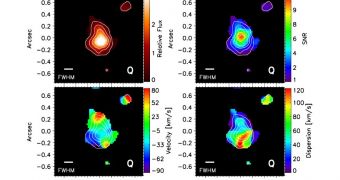In a nice twist of events, astronomers at the University of Hawaii in Manoa announce the discovery of a normal galaxy in the distant Universe. Usually, when experts probe the deep Cosmos, they tend to come across very weird and unusual objects, so this study should provide a good point of reference for other investigations.
The team, led by UHM astronomer Regina Jorgenson, was able to produce one of the most detailed views of the composition and size of a regular, ancient galaxy. Details of the research were presented at the 223rd annual meeting of the American Astronomical Society (AAS), held in Washington DC.
According to the group, the galaxy is nearly invisible in most wavelengths, due to its extreme distance from Earth. Signs of its existence can only be identified by looking at its faint emissions in narrow range of frequencies. The distant object is called DLA2222-0946.
Astronomers believe that objects like this one represented the kernels on which larger, spiral galaxies such as the Milky Way eventually formed. Our galaxy, for example, is around 10 billion years old.
The UHM group was able to obtain the first-ever spatially resolved image of members of this class of galaxies by using the W. M. Keck Observatory, which lies atop Mauna Kea, in Hawaii. No other astronomy group was ever able to see such an object directly.
The work was led by Jorgenson, who is postdoctoral astronomy and astrophysics fellow with the US National Science Foundation (NSF), and holds an appointment with the Institute of Astronomy at UHM. He worked closely together with University of California in San Diego (UCSD) colleague Dr Arthur Wolfe on this investigation.
The distant object was not recognized as a galaxy when first found. At first, astronomers thought it was a damped Lyman-alpha system, a class of formations that absorb radiations from bright sources behind them at specific wavelengths. Such light sources include quasars and blazars.
It was only after considerable follow-up studies that DLA2222-0946 was confirmed to be a regular galaxy standing in front of an even more distant quasar, as seen from our frame of reference.
“These galaxies are extraordinary for being ordinary – they represent normal types of galaxies, rather than the brightest, extreme, and most rapidly star-forming galaxies that are typically observed at these redshifts,” Jorgenson said at the AAS presentation.
“But this normalcy makes them nearly impossible to detect directly from the light they give off because first, that emission is relatively weak, and second, the bright background quasar used to find the galaxy hampers the detection of fainter foreground emission from the galaxy itself,” she concluded.

 14 DAY TRIAL //
14 DAY TRIAL //